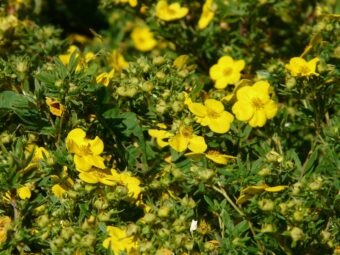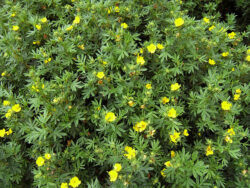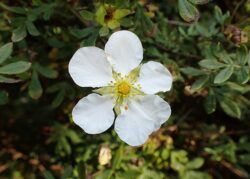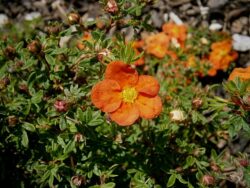In this article, we will discuss how to grow Dasiphora, especially Dasiphora fruticosa (syn. Potentilla fruticosa) in containers. Dasiphora is a genus of ten species of shrubs that belong to the Rosaceae (the rose) family, which are native to Asia. Dasiphora fruticosa in particularly once belong to Potentilla, a genus of 300 species, but it is now separated. Potentilla is a confusing genus as so many species have been moved in and out of the family. It was found that Dasiphora and Potentilla are distinctive enough not to belong to the same family. Dasiphora fruticosa is often found in cool, northern climates.

It is an ordinary-looking shrub with green leaves that are divided into five (occasionally 3 or 7) leaflets arranged in a pinnate form and hence why it is called cinquefoil (from the French cinque feuilles meaning 5 leaves). The leaves are deciduous and will be lost in autumn.
It only grows up to 1m in height and has a sprawling or prostrate growing habit, where stems cascade over the edge. It is grown for the flowers that are produced terminally on the stems and are buttercup-like with 5 petals and 15-25 stamens. The petals can be white, pale yellow, orange, pink or even red. The flowers are followed by dry, red fruits that are covered with long hairs. It flowers from late May to September.
Find out how to grow Dasiphora in containers, in particular Dasiphora fruticosa.
GROWING DASIPHORA IN CONTAINERS

First, choose a container that has plenty of drainage holes at the bottom and will suit the plant in question and will be well balanced. To this container add a layer of gravel to a depth of 2cm as this will aid drainage further. On top of this add multipurpose compost to within 5cm of the top rim of the container.
Dig a hole in the centre of the container slightly bigger than the root ball it came in the original container that you bought it in. Drop the plant in so that the top of the root ball is at the same level as the top surface of the compost in the container. Backfill with the growing media so that no vacant species remain, using more compost if you find it necessary. You will need to water well after you have firmed the plant in.
THE BEST GROWING CONDITIONS
The good news is that the shrubby cinquefoils are easy to grow, not requiring much in the way of care, It is best to place the containers where they will get as much light as possible. They can take some shade but the flowers will not be as showy.
They will need to be watered frequently until the plant is well-established, especially if it gets no moisture for a long period of time. The compost must not be left to dry out at all and at the same time, it does not appreciate being waterlogged. Water as soon as the surface of the container feels dry to the touch and water until it emerges from the drainage holes.

This is not a hungry plant but in containers, you can use fertilizer at half the recommended dosage. I would recommend that you use a general-purpose, slow-release fertilizer as this will have the right amount of nutrients the plant will need to get it through the whole year.
PRUNING AND PROPAGATION METHODS
Pruning is very important and the shrub will benefit if it is done right. It is best to cut and remove unwanted or damaged branches in spring, whilst cutting back young strong grown by about one-third. If the plant gets overgrown, you can cut it back to 10cm above the ground. It will grow again, greener, denser and it will flower greatly.
Propagation is normally carried out in summer, where semi-ripe cuttings can be taken and placed in a cold frame. Alternatively, you can take a root division by dividing the plant in your container once it has become root bound. All you need to do is take the plant of the container and divide the shrub into various divisions. Make sure each division has enough growing points and roots and it will do well. These divisions must be planted straight away in new containers, using new compost, and soon you will have new plants.
PESTS AND DISEASES
They can suffer from aphid attacks, which cause the leaves to curl up or grow deformed. If this is found first blast them with jets of water but if this does not work, you will need to use a suitable insecticide that will work for this problem.
They can suffer from leaf spot diseases caused by various fungus which causes brownish leaf spots. This is caused by having too much moisture at the roots and unfavourable growing conditions or insufficient ventilation around the plant. If this happens, affected leaves must be cut off. If the fungal infection spread you will need to use a broad-spectrum fungicide on a regular basis.
Powder and Downy mildews can happen if the growing conditions are not right. If the plants are too close together and the air is insufficient around the shrub, along with it being dry at the roots will result in these conditions. If possible, the only way is to avoid it by watering at the roots and improving air circulation and ventilation between the plants. You should try and if everything else fails you will have to use a fungicide that will work with fungal diseases.
VARIETIES TO GROW

The main species that you will find is Dasiphora fruticosa (Syn. Potentilla fruticosa) which has been described in the introduction. Many varieties can be found and this includes:
‘Abbotswood’ produces white flowers and grows up to 75cm tall.
‘Creme Brule’ grows up to I’m tall and produces bright white flowers.
‘Day Dawn’ produces salmon-orange flowers, where it grows up to 1m high.
‘Elizabeth’ produces yellow flowers and grows up to 90cm tall.
‘Goldfinger’ produce golden yellow flowers and grows up to 1.2m tall/
‘Hachmann’s Gigant’ produces yellow flowers and grows up to 1m high.
‘Hopleys Orange’ produces orange flowers and grows to 1m tall.
‘Jackman’s Variety’ produces yellow flows and grows up to 1.2m tall.
‘Kobold’ produces bright yellow flowers and grows up to 80cm high.
‘Lovely Pink’ produces pink flowers and grows up to 1m high.
‘Lemon Meringue‘ produces yellow and white flowers and grows up to 1m.
‘Limelight’ produces white flowers and grows up to 1m tall.
‘Mango Tango’ has yellow flowers and grows up to 60cm.
‘Marion Red Robin’ produces orange-red flowers and grows up to 1m tall.
‘Medicine Wheel Mountain’ produces yellow flowers and grows up to 50cm high.
‘Mount Everest’ produces white flowers and grows up to 1m tall.
‘Pink Paradise’ produces an abundance of pink flowers, where it grows up to 0.75m high.
‘Pretty Polly’ has pretty pink flowers and grows up to 1m high.
‘Red Ace’ produces bright red-orange flowers, where it grows up to 70cm high.
‘Sommerflor’ grow up to 1m tall and produces bright yellow flowers.
‘Tangerine’ as its name applies produces orange-yellow flowers and grows up to 1m tall.
‘Northern Dykes’ produces yellow flowers and grows up to 1.5m tall.
‘Manchu’ only grows up to 30cm tall and produces white flowers.
‘Primrose Beauty’ as its name implies produces yellow primrose-coloured flowers and grows up to in tall.
‘Princess’ grows up to 60cm tall and produces pink flowers.
‘Tilford Cream’ produces creamy-whiter flowers and grows up to 45cm high.
‘White Lady’ produces brilliant white flowers and grows up to 1m high/
CONCLUSIONS
In this article, we have discussed how to grow the popular and pretty shrub of Dasiphora in containers. The main species is Dasiphora fruticosa, which is easy to look after and care for and many varieties exist. It is a good plant to grow in containers as it is not fussy, so why not grow one today?
If you have any questions or comments that you wish to name on growing Dasiphora in containers, please do so in the comment box below.
Happy Dasiphora growing.
